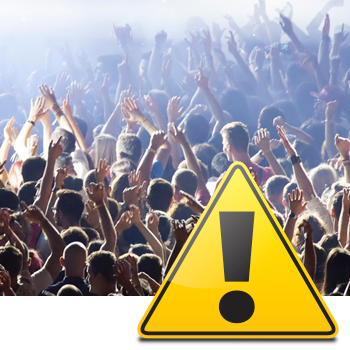
Fun these days seems to come with crowds. In the middle of enjoying a concert or strolling through a festival, it’s easy to forget that being in a crowd also holds an element of danger. If a crowd becomes panicked, for instance, people can get injured or even killed.
The facts are, from 1992 through 2002, there were 232 deaths from crowd-safety failures at concerts and festivals around the world, and more than 66,000 people were injured. More recently, on July 24, 2010, the 2010 German Love Parade was marred by tragedy when 21 people were killed and over 500 were injured due to crushing and trampling.
An analysis of this tragedy was published recently (PDF) by researchers at Cornell University. The two scientists, Dirk Helbing and Pratik Mukerji, laid the blame not on panic or stampeding, however, but on a phenomenon known as a “crowd quake.”
A “crowd quake” occurs when people are pressed up against each other so tightly that any movement is transmitted from one body to the next, and the force starts to add up. “Under such conditions, the sizes and directions of forces acting on the bodies of visitors move them around in an uncontrolled way, and people have difficulties keeping their balance; when people stumble and fall, this can be the nucleus of a crowd disaster,” the authors wrote.
With thousands of concert-goers injured each year, it is important to recognize the possible safety risks and to take steps to minimize them. Here’s what safety experts recommend:
- Review an event venue before you attend, read what previous concert goers had to say about safety and security.
- Arrive early to give yourself plenty of time to search out the nearest exits and locations of the security office and medical services. When entering a venue, check the emergency exits and share and confirm the locations and status with your companions. As you position yourself in the venue, make a note of the nearest exit, preferably a secondary exit — NOT the main entry/exit.
- Look to see if the planners have installed a “T” or “H” barrier in the audience, to limit the number of people who can congregate in any one area. Responsible concert planners have installed these safety barriers for decades.
- To avoid a crowd’s rush to leave following a performance, consider departing before the end of the show.
Responsible venue managers and promoters will put the safety of their visitors before profits at the gate by, among other things, planning for the number of people expected rather than what the venue will hold. They will limit the number of people allowed to what a space can safely accommodate, and they will follow other best practices related to crowd management. They have a legal and moral responsibility to do so.
The bottom line is, anytime you and your friends and family plan to spend time in a large crowd, stay alert and agree on a quick exit strategy should the need arise. Then go enjoy yourselves.
